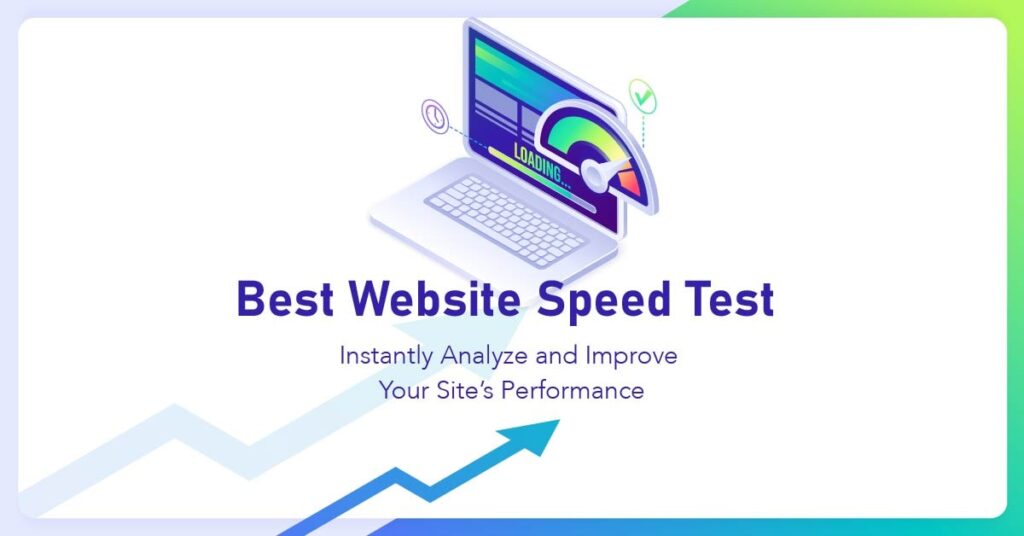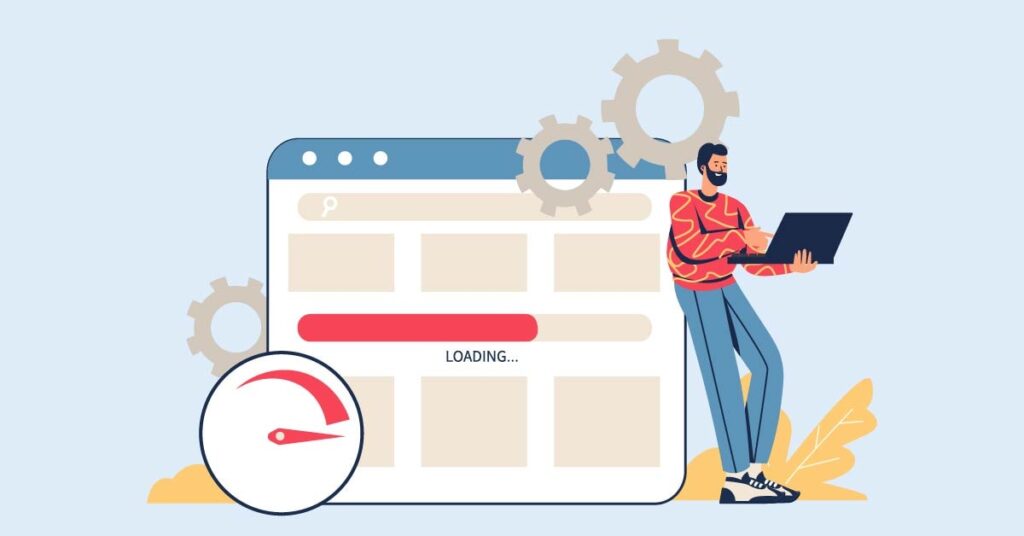
Curious if your website loads quickly enough? A website speed test tool can help you find out by entering your website url and measuring your site speed. In this guide, you’ll learn how to conduct a full website speed test, understand the results, analyze and boost your site’s performance.
Website speed is crucial for user satisfaction, conversion rates, and SEO rankings; even minor delays can negatively impact user engagement.
Free website speed tests provide insights into performance bottlenecks, assessing loading speeds, response times, and visual stability to identify areas for improvement.
Implementing strategies like image optimization, minifying code, and leveraging browser caching can significantly enhance website load times and overall performance.
Importance of Website Speed and Page Load Time

Website speed is a critical factor for engaging and satisfying visitors, as a slow website can lead to frustration and higher bounce rates. Even a slight delay of 50 milliseconds can affect user perception of your site’s performance. In today’s fast-paced digital era, rapid page speeds are essential, not just a luxury. Quick-loading sites often see increased conversion rates, as users are more likely to stay and explore.
Conversely, slow pages can drive potential customers away, resulting in missed sales opportunities. Fast websites also project professionalism and trustworthiness, signaling effectiveness and dependability. Moreover, search engines favor faster sites, incorporating page speed into their ranking algorithms to enhance user experience. Prioritizing website speed improvements is crucial for boosting visitor satisfaction and search engine rankings.
How to Perform a Free Website Speed Test

Conducting a free website speed test provides essential insights into your site’s performance by evaluating elements that affect load times, such as HTML, JavaScript, CSS files, and images. Simply enter your URL to engage a full page speed checker, which identifies both fast and sluggish components.
Testing from multiple global locations reveals how geographic factors and server distribution impact loading speeds. Recognizing server response codes helps identify errors that may slow down resource access. Regular assessments with speed test tools ensure optimal performance, offering lab-based analyses that emulate diverse network environments for a better user experience.
Understanding Page Speed Metrics

Utilizing a page speed checker is a crucial tool for assessing website performance and user experience by providing insights into page speed metrics. Core Web Vitals, such as Largest Contentful Paint (LCP), Interaction to Next Paint (INP), and Cumulative Layout Shift (CLS), are essential for understanding how effectively a website loads, remains interactive, and maintains visual stability. An optimal web experience requires LCP within 2.5 seconds, INP under 200 milliseconds, and CLS less than 0.1 to ensure minimal layout shifts and quick response times.
It’s important to differentiate between theoretical speeds and actual performance seen through speed test results, as real-world usage can vary due to network conditions. Data from lab settings during speed tests provide comprehensive details on download and upload rates, along with latency issues, offering insights integral to fine-tuning your webpage’s performance and enhancing overall site responsiveness.
Common Issues Affecting Website Speed

Several prevalent issues can hinder website speed and performance. Shared hosting often limits resources, leading to reduced efficiency, especially during peak web traffic periods. Bandwidth competition on the same server can further slow loading times. The accumulation of HTTP requests from page components, like images and scripts, strains servers, resulting in extended load times.
Redirects add additional HTTP requests, delaying site loading. Recognizing these challenges allows for proactive measures to optimize resource usage, reduce unnecessary HTTP requests, and ensure rapid user access, ultimately enhancing both server speed and user experience.
Tools for Website Speed Testing

There are numerous tools available to identify performance issues that can affect user experience and search engine rankings. Tools like Google PageSpeed Insights, GTmetrix, and Pingdom are invaluable for evaluating website load speed, offering actionable recommendations to enhance your site’s performance.
These speed test tools are crucial for assessing and improving site performance, as they help track load times, identify delay-causing areas, and implement changes to boost speed. Regular use of these website speed test tools ensures that your website maintains optimal speed and functions efficiently, enhancing user engagement and satisfaction.
Google PageSpeed Insights
PageSpeed Insights by Google is a vital tool for assessing website performance across mobile and desktop platforms. It provides essential metrics to evaluate and enhance site performance, highlighting areas for improvement that can boost user experience. By following the tool’s recommendations, you can improve page speed, potentially enhancing SEO rankings and user engagement. Implementing the suggestions from PageSpeed Insights ensures your website performs optimally on all devices, satisfying both users and search engines.
GTmetrix
GTmetrix is a comprehensive tool for analyzing website speed and performance, generating detailed reports with waterfall charts to track page loading sequences. It aggregates data from resources like Google Lighthouse and Web Vitals, providing insights into various performance metrics to help users identify delays and potential enhancements. With these insights, users can make informed decisions to improve their website’s speed and overall user experience.
Pingdom
Using Pingdom, users can assess website loading speed from various global locations to simulate diverse user experiences. This tool monitors how quickly websites load across different devices and networks, providing a comprehensive performance overview. With Pingdom’s filmstrip feature, users can visualize the step-by-step loading process, enabling better resource management. Based on test results, Pingdom offers tailored advice to enhance site efficiency by breaking down load times for specific scripts and resources. This detailed analysis helps identify elements that may slow down page speed, allowing users to make informed improvements to optimize overall website performance.
Interpreting Speed Test Results

Grasping website speed test results is essential for effectively addressing performance issues. Each test request links to a unique Ray ID, aiding in diagnosing network efficiency problems. Factors like internet connection type, such as Ethernet or Wi-Fi, greatly impact initial results, given their differing bandwidth capacities.
Google’s PageSpeed Insights combines empirical field data from the Chrome User Experience Report with lab data from the Lighthouse API, offering a comprehensive analysis of user experience metrics, diagnostics, and enhancement opportunities. Interpreting these results is crucial for implementing changes that not only boost website speed but also improve overall visitor satisfaction.
Optimizing Website Performance

Enhancing website performance is vital for improving load times and user experience. Key strategies include optimizing images to reduce file sizes without sacrificing quality, minifying CSS and JavaScript to eliminate redundant code, and leveraging browser caching to store data on users’ devices for quicker access.
Addressing bloated or poorly optimized code and unnecessary scripts can significantly boost speed and reactivity. These approaches collectively decrease load times and enhance overall website efficiency, ensuring a smoother and faster user experience, which is crucial for maintaining user engagement and improving search engine rankings.
Image Optimization
Optimizing images is essential for enhancing website speed and performance. By choosing the right formats like JPEG for photos and PNG for graphics with transparency, and resizing images to necessary dimensions before uploading, you can significantly reduce file sizes. Compression techniques further minimize sizes, improving load times without compromising visual quality. These strategies collectively ensure faster loading speeds, contributing to a more efficient website and better user experience.
Minifying CSS Files and JavaScript
The process of minification strips away redundant characters from code, which helps to decrease file sizes and contributes to accelerated load speeds. By getting rid of these superfluous characters, the speed at which web pages are rendered is increased, leading to faster file transfers and an enhancement in overall page loading velocity.
Leveraging Browser Caching
Utilizing browser caching is crucial for enhancing website speed and performance by storing data on visitors’ devices, leading to faster load times on return visits. By caching static assets like images, stylesheets, and JavaScript files locally, browsers can quickly access these resources in future visits, significantly reducing page load times.
Setting expiration headers for static elements allows control over how long this data remains on users’ devices. Implementing cache-control and expires headers manages resource longevity in browser caches, minimizing server requests and enhancing user experience with smoother interactions for repeat visits.
Monitoring Website Performance

Monitoring website performance metrics is crucial for swiftly identifying and resolving issues that impact speed and user experience. Alerts for slow response times via SMS and email ensure timely awareness and maintain user satisfaction. Performance monitoring tools assess page load speeds using key indicators like Time To First Byte (TTFB) and First Contentful Paint (FCP).
Synthetic user monitoring simulates actions across devices, while real user monitoring collects actual interaction data, providing insights into loading speeds and errors. These metrics enable prompt problem-solving without constant oversight.
Advanced Techniques for Web Developers

Switching to the HTTP/2 protocol offers web developers enhanced website speed through features like multiplexing and header compression, which expedite data transfer. Incorporating lazy loading optimizes page load times by delaying non-critical resource retrieval until necessary, benefiting multimedia-rich sites. Developers have access to advanced methods and tools, such as HTTP/2 and lazy loading, to significantly improve website speed and performance, ultimately elevating user experience by ensuring faster website operations.
Summary

The speed of your website is a crucial factor affecting technical performance, user satisfaction, engagement, and SEO. Quick page loads are essential, and leveraging free tools like Google PageSpeed Insights, GTmetrix, and Pingdom for performance evaluation is vital. Improving efficiency involves optimizing graphics, minimizing code, implementing browser caching, and adopting modern protocols like HTTP/2 and lazy loading. Regular monitoring ensures optimal speed, enhancing user experience, brand reputation, and search visibility. Transform your website into an efficient digital powerhouse by refining its speed and performance today.
Frequently Asked Questions
Why is website speed important?
Website speed is crucial as it significantly impacts user engagement, satisfaction, and conversion rates, while also enhancing SEO rankings. Faster website performance improves the overall user experience, making it essential for maintaining high conversion rates and achieving better search engine visibility
How can I perform a free website speed test?
Performing a free website speed test is simple with tools and services like Google PageSpeed Insights, GTmetrix, or Pingdom. By entering your site’s URL, these tools offer valuable insights into your site’s performance and highlight areas needing improvement, helping you enhance speed and user experience.
What are Core Web Vitals or Large Contentful Paint?
Core Web Vitals are essential metrics for evaluating a web page’s performance, focusing on load times, user interaction, and visual stability. These indicators include Largest Contentful Paint (LCP), Interaction to Next Paint (INP), and Cumulative Layout Shift (CLS). Prioritizing these metrics is crucial for enhancing user experience and improving a website’s search engine ranking.
What are common issues that slow down a website?
Common issues that slow down a website include slow shared hosting plans, excessive HTTP requests, and redirects. To boost speed, it’s crucial to optimize server resources, cut down on HTTP requests, and minimize redirects. By addressing these factors, you can significantly enhance your website’s performance and ensure a smoother, faster user experience.
How can I optimize my website's performance?
To enhance your website’s performance and user experience, focus on optimizing images, reducing CSS and JavaScript file sizes through minification, and utilizing browser caching. Additionally, implementing advanced techniques like HTTP/2 and lazy loading can significantly boost your site’s loading speed.





